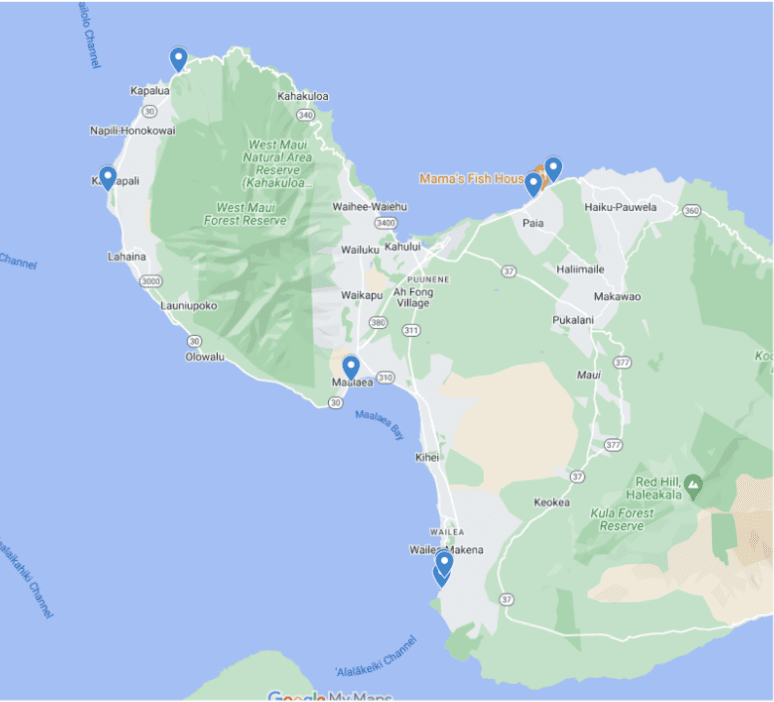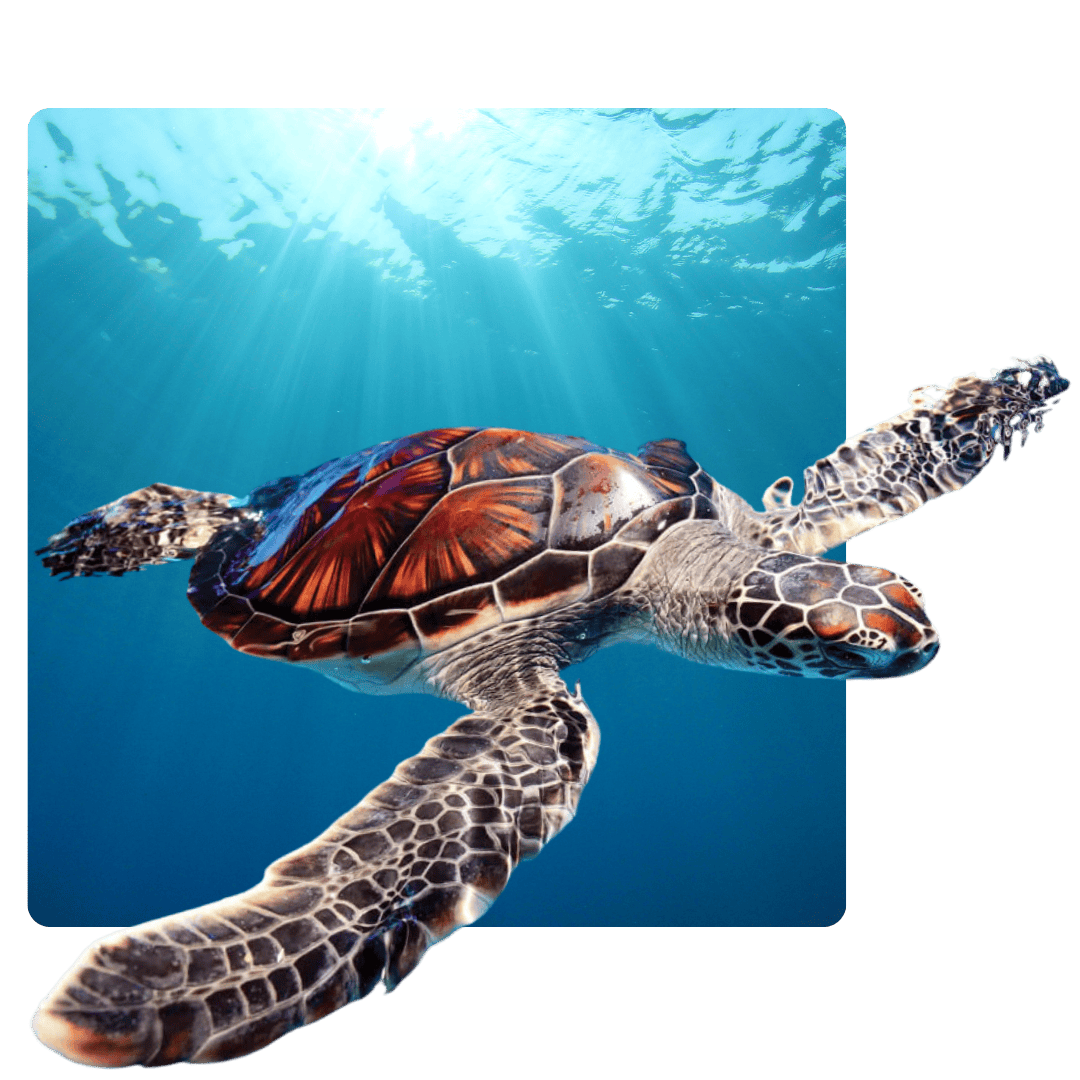Maui is home to some of the most beautiful beaches in the world, and it’s no surprise that many of them are also great spots to see Honu (Hawaiian green sea turtles). When setting out to see our local Honu, it’s important to be mindful of the natural environment and adhere to any posted guidelines or regulations. Additionally, keep in mind that conditions at beaches can change, and it’s advisable to check local sources for the latest information and any updates on beach conditions.
Sea turtles are protected under both federal and state laws. Both NOAA and DLNR recommend staying at least 10 feet, or 3 meters, away from the sea turtles at all times. It’s against the law to touch or harass sea turtles, so remember to keep your distance and admire our beautiful Honu from a distance.
Without further ado, here is a round up of some of the best beaches in Maui to see turtles:
Ho’okipa Beach is considered one of the windsurfing and kitesurfing capitals of the world. The beach’s strong and consistent trade winds, along with its powerful waves, attract professional windsurfers and kitesurfers from around the globe. It’s also known for its large population of turtles. You can spot up to 15-20 turtles napping on the sandy shore at any one time. Afternoons seem to be the best time of day for turtle watching, but you’ll probably see at least a few on the beach in the morning, too.
Ho’okipa Beach Park is open from 5:30 AM to 7:00 PM every day. Parking is free and plentiful. There’s a total of three parking lots available with a combined 170 parking spaces. Please note that the gates will be locked after hours, so make sure you leave before the park closes.
Kū’au Bay Beach Park, also known as Kaulahao Beach, is a small beach located on the north side of Maui. This unsung gem of a beach is a more exclusive spot to see turtles. You’ll find sea turtles napping just about anywhere on this sandy beach. The best time to see them is during sunset when they come to rest on the shore and the sky changes color.
The beach is known for its coarse sand and deep blue water, snorkeling is possible from right off the beach so make sure to pack your gear. The beach has a free parking lot but no bathrooms.
Black Rock is located at the northern end of Ka’anapali Beach, near the Sheraton Maui Resort & Spa. It is easily accessible, and visitors can access the area from the beach or by walking along the lava rock path. The beach gets its name from the large lava rock promontory that juts into the ocean. This unique geological feature is known as Pu’u Keka’a and serves as a popular spot for cliff jumping and snorkeling. This beach is a popular spot for snorkeling because of its clear visibility, vibrant coral reefs, and diverse fish species. It’s also home to – you guessed it – a large population of turtles.
There are three parking options available for Black Rock Beach. The first option is to park at the free parking lot located at the Whaler’s Village parking garage. The second option is to park at the paid parking lot located at the Sheraton Maui Resort & Spa. The third option is to park at the free parking lot located at Kahekili Beach Park and walk south on the beach walk.
If you plan on cliff diving, the best time to visit is during the sunset when the cliff divers light torches along the cliff before jumping off Black Rock.
This beach is a bit off the beaten path, but it’s worth the trek to see the turtles. Mokulē‘ia Beach, is a beautiful and less crowded beach located off of Rte. 30 in Mokulē‘ia Bay, directly east of Fleming Beach and directly west of Honolua Bay.
The beach is at the bottom of a steep cliff, which is covered by heavy vegetation. There is a small parking lot at the top of the cliff, where you can look down and get a glimpse of the beach. Then there’s a long steep concrete stairway with distinctive green handrails, that leads you 88 stairs down to a short rocky pathway, heading to the beach.
Slaughterhouse Beach is a picturesque beach with big waves crashing up to the beach. Though not known as a Maui surfing beach, it’s still fun for experienced bodyboarders. The beach is sandy, unlike the rocky Honolua Bay beach next door. These two bays together make up the Honolua-Mokulē‘ia Bay Marine Life Conservation District.
There’s a good chance you’ll find turtles on the beach, and an even better chance you’ll see some in the water. Turtles are more likely to be seen while snorkeling near rocky outcrops or coral formations. They may be more active during certain times of the day. Early mornings or late afternoons could be good times for wildlife viewing. Keep a respectful distance and observe them without disturbing their natural behavior.
This beach is a secluded spot that’s perfect for a quiet day of turtle watching. Five Graves, also known as Five Caves, is a popular snorkeling and diving spot located in South Maui. The site is named after the small family graveyard located just south of the beach believed to be the final resting place of a family that lived in the area in the early 1900s . The graves are located on a small hill overlooking the ocean, and are surrounded by a low rock wall.
The area is home to a variety of aquatic life, including Pacific snake eels, schools of needlefish, and Honu. The site is accessible by boat or kayak, but it can also be reached by swimming from Makena Landing around the point. The area is recommended for experienced snorkelers and swimmers due to currents, rocky shoreline, and distance to swim.
Maluʻaka Beach is known as Turtle Beach because of the abundance of sea turtles that can be seen swimming in the area. Maluaka Beach, is located in South Maui and is known for its golden sand, clear blue water, and excellent snorkeling opportunities.
For the best chance at seeing turtles, snorkel near the rocky shore at either the north end or south end of the beach. Just watch out for the rogue wave that might push you into the rocks. Mornings are typically better for avoiding high surf conditions while snorkeling at Maluʻaka Beach.
To get to Maluʻaka Beach, you can park at either end of the beach. There are parking lots, restrooms, and showers available at both ends of the beach, which are connected by a paved walking path. If you are coming from Wailea Alanui Road, take the turnoff to go to Keawala’i Church and Makena Landing. Where the road splits to go to Makena Landing or the church, turn left to reach Maluʻaka Beach
There isn’t a “best” time to see sea turtles in Maui. It’s important to remember that sea turtles are wild animals and your ability to see them on any given day varies.
With that said, sea turtles are more active during the morning and in the evening, so if your hope is to see one (or a few), prioritize snorkeling or diving around these times.
The water is most calm between May and September so your chances also increase during those months.
It’s difficult to say exactly which beach in Maui has the most turtles. While sightings can vary depending on the day and environmental factors, some beaches are known to have more sea turtles or more frequent sea turtle sightings.
This beach is known as “Turtle Beach” for a reason. The high amount of lava tubes and coral reefs near the shore provide shelter and a source of food. What this means for you is it offers a high chance of encountering sea turtles. Because the waters tend to be more calm in the morning, we recommend early mornings as the best time to see turtles here.
Makena Landing is another popular spot for sea turtles. The beach is located in a marine protected area, which helps conserve the sea turtle population. With clear waters and shallow reefs, it may be easier to snorkel and spot turtles in their natural habitat.
If you’re here with us on Maui for one day, one week, or one month, we recommend going to see our sea turtles. Yes, you can see turtles in Maui without snorkeling. This is because some beaches are known for turtles basking on the shore, especially in the early mornings or evenings. (Snorkeling does often offer the best chance of seeing turtles underwater in their natural habitat, however.)
When spotting turtles from land, there are a couple things to note. Bring a pair of binoculars so you get a better look at these turtles from a distance. It’s important to give these turtles space (at least 10 feet) to avoid disturbing them.
You can swim and snorkel near sea turtles in Maui, but you must be respectful. Hawaiian Green sea turtles and Hawksbill sea turtles are the most common species in Maui, and are both protected by law. It is illegal to harass, touch, chase, or feed them. To avoid issues, please maintain a safe distance of at least 10 feet.
It’s hard to pinpoint which Hawaiian island exactly has the most turtles, but it’s suggested that the Big Island of Hawai’i is the frontrunner.
A few reasons for the Big Island’s popularity include the French Frigate Shoals—which act as an important nesting ground for sea turtles—and the Kohala Coast, which offers an abundance of food sources and protected coves.
Maui is also a great island for sea turtles given its ideal living conditions. Coral reefs offer plenty of food, including algae and seagrasses, and Maui’s coves, inlets, and lava rock formations provide shelter for turtles to rest and hide. Given that sea turtles are cold-blooded reptiles, the warm tropical waters around Maui offer a comfortable environment.
You can also see Honu at our Turtle Lagoon exhibit. Get your tickets now.

The Hawaiian green sea turtles mating season typically occurs during the summer months. The exact timing can vary, but it generally spans from June to September. During the mating season, male green sea turtles actively pursue females in the water. Mating often involves courtship behaviors, with males attempting to mount the females. Once mating is successful, female turtles come ashore to nest.
Nesting season for Hawaiian green sea turtles usually begins in late spring and continues into the summer. Female turtles crawl onto sandy beaches, dig a nest, and lay their eggs. After laying the eggs, they carefully cover the nest before returning to the ocean.
It’s important to note that observing sea turtles during their nesting season should be done with great care and respect for these protected species. Many areas with known sea turtle nesting sites have guidelines and regulations in place to protect the turtles and their habitats. Always follow local guidelines and consider joining organized tours led by knowledgeable guides who can ensure a responsible and educational experience.
Lastly, Maui Ocean Center’s Turtle Lagoon is a great place to visit if you want to see Hawaiian green sea turtles up close and personal. The exhibit features up to six Hawaiian green sea turtles that are showcased in both above and underwater views, allowing visitors to get a closer look at these magnificent creatures.
The Maui Ocean Center is committed to the conservation and protection of these turtles. The Turtle Lagoon is a dedicated area designed specifically for the care and exhibition of sea turtles. The turtles are raised at Sea Life Park on Oahu and are brought to the Maui Ocean Center when they are hatchlings. They are raised for roughly two years until they have grown large enough to be released into the wild. The lagoon itself features a spacious and carefully maintained habitat that closely mimics the turtles’ natural surroundings. It incorporates elements such as rocks, plants, and a sandy bottom to create a realistic and comfortable environment for the turtles.
In addition to the exhibit, the Maui Ocean Center offers educational programs and interactive displays at the Turtle Lagoon. These initiatives aim to raise awareness about sea turtles, their conservation, and the threats they face in the wild. The Maui Ocean Center also implements monitoring and research initiatives to track the progress and well-being of the released turtles!
Reserve your tickets today and receive a $5 discount on your admission fee by booking online!
Immerse Yourself in our SEA-News featuring Hawaiʻi’s marine life, inspirational conservation, and glimpses behind-the-scenes.


